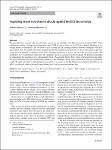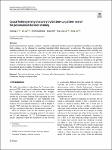Tìm kiếm
Tác giả
- Nora, El-Rashidy (3)
- Christian, Homeyer (2)
- Haebom, Lee (2)
- Héctor, Martínez (2)
- Sau >
Chủ đề
- Artificial Intelligence (3)
- artificial intelligence (3)
- CNNs (3)
- DNNs (3)
- Sau >
Năm xuất bản
Toàn văn
- true (282)
Kết quả tìm kiếm
We present a novel hypergraph-based framework enabling an assessment of the importance of binary classification data elements. Specifically, we apply the hypergraph model to rate data samples’ and categorical feature values’ relevance to classification labels. The proposed Hypergraph-based Importance ratings are theoretically grounded on the hypergraph cut conductance minimization concept. As a result of using hypergraph representation, which is a lossless representation from the perspective of higher-order relationships in data, our approach allows for more precise exploitation of the information on feature and sample coincidences. The solution was tested using two scenarios: undersampling for imbalanced classification data and feature selection. |
Recent publications consider side-channel attacks against the key schedule of the Data Encryption Standard (DES). These publications identify a leakage model depending on the XOR of register values in the DES key schedule. Building on this leakage model, we first revisit a discrete model which assumes that the Hamming distances between subsequent round keys leak without error. We analyze this model formally and provide theoretical explanations for observations made in previous works. Next we examine a continuous model which considers more points of interest and also takes noise into account. |
In this study, we propose a new genetic algorithm that uses a statistical-based chromosome replacement strategy determined by the empirical distribution of the objective function values. The proposed genetic algorithm is further used in the training process of a multiplicative neuron model artificial neural network. The objective function value for the genetic algorithm is the root mean square error of the multiplicative neuron model artificial neural network prediction. This combination of methods is proposed for a particular type of problems, that is, time-series prediction. |
Difficulty in emotion expression and recognition is typical of the personality trait known as alexithymia, which is often observed in persons with neurodevelopmental disorders (NDD). Past research has investigated various forms of conversational technology for people with NDD, but only a few studies have explored the use of conversational agents to reduce alexithymia. This paper presents Emoty, a speech-based conversational agent designed for people with NDD to train emotional communication skills. |
Heterogeneous computing is the major driving factor in designing new energy-efficient high-performance computing systems. Despite the broad adoption of GPUs and other specialized architectures, the interest in spatial architectures like field-programmable gate arrays (FPGAs) has grown. While combining high performance, low power consumption and high adaptability constitute an advantage, these devices still suffer from a weak software ecosystem, which forces application developers to use tools requiring deep knowledge of the underlying system, often leaving legacy code (e.g., Fortran applications) unsupported. |
Zero-shot learning (ZSL) aims at recognizing classes for which no visual sample is available at training time. To address this issue, one can rely on a semantic description of each class. A typical ZSL model learns a mapping between the visual samples of seen classes and the corresponding semantic descriptions, in order to do the same on unseen classes at test time. State of the art approaches rely on generative models that synthesize visual features from the prototype of a class, such that a classifier can then be learned in a supervised manner. However, these approaches are usually biased towards seen classes whose visual instances are the only one that can be matched to a given class prototype. |
Coronavirus Disease 2019 (COVID-19), which is caused by Severe Acute Respiratory Syndrome Coronavirus 2 (SARS-COV-2), surprised the world in December 2019 and has threatened the lives of millions of people. Countries all over the world closed worship places and shops, prevented gatherings, and implemented curfews to stand against the spread of COVID-19. Deep Learning (DL) and Artificial Intelligence (AI) can have a great role in detecting and fighting this disease. Deep learning can be used to detect COVID-19 symptoms and signs from different imaging modalities, such as X-Ray, Computed Tomography (CT), and Ultrasound Images (US). This could help in identifying COVID-19 cases as a first step to curing them. In this paper, we reviewed the research studies conducted from January 2020 t... |
In personalised decision making, evidence is required to determine whether an action (treatment) is suitable for an individual. Such evidence can be obtained by modelling treatment effect heterogeneity in subgroups. The existing interpretable modelling methods take a top-down approach to search for subgroups with heterogeneous treatment effects and they may miss the most specific and relevant context for an individual. In this paper, we design a Treatment effect pattern (TEP) to represent treatment effect heterogeneity in data. To achieve an interpretable presentation of TEPs, we use a local causal structure around the outcome to explicitly show how those important variables are used in modelling. We also derive a formula for unbiasedly estimating the Conditional Average Causal Effe... |
The advent of the Big Data era has brought considerable challenges to storing and managing massive data. Moreover, distributed storage systems are critical to the pressure and storage capacity costs. The Ceph cloud storage system only selects data storage nodes based on node storage capacity. This node selection method results in load imbalance and limited storage scenarios in heterogeneous storage systems. Therefore, we add node heterogeneity, network state, and node load as performance weights to the CRUSH algorithm and optimize the performance of the Ceph system by improving load balancing. We designed a cloud storage system model based on Software Defined Network (SDN) technology. |
Developing Graphics Frameworks with Python and OpenGL shows you how to create software for rendering complete three-dimensional scenes. The authors explain the foundational theoretical concepts as well as the practical programming techniques that will enable you to create your own animated and interactive computer-generated worlds. You will learn how to combine the power of OpenGL, the most widely adopted cross-platform API for GPU programming, with the accessibility and versatility of the Python programming language. Topics you will explore include generating geometric shapes, transforming objects with matrices, applying image-based textures to surfaces, and lighting your scene. Advanced sections explain how to implement procedurally generated textures, postprocessing effects, and ... |










